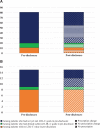Impact of a Population Genomic Screening Program on Health Behaviors Related to Familial Hypercholesterolemia Risk Reduction
- PMID: 35862023
- PMCID: PMC9584046
- DOI: 10.1161/CIRCGEN.121.003549
Impact of a Population Genomic Screening Program on Health Behaviors Related to Familial Hypercholesterolemia Risk Reduction
Abstract
Background: Limited information is available regarding clinician and participant behaviors after disclosure of genomic risk variants for familial hypercholesterolemia (FH) from a population genomic screening program.
Methods: We conducted a retrospective cohort study of MyCode participants with an FH risk variant beginning 2 years before disclosure until January 16, 2019. We analyzed lipid-lowering prescriptions (clinician behavior), medication adherence (participant behavior), and LDL (low-density lipoprotein) cholesterol levels (health outcome impact) pre- and post-disclosure. Data were collected from electronic health records and claims.
Results: The cohort included 96 participants of mean age 57 (22-90) years with median follow-up of 14 (range, 3-39) months. Most (90%) had a hypercholesterolemia diagnosis but no specific FH diagnosis before disclosure; 29% had an FH diagnosis post-disclosure. After disclosure, clinicians made 36 prescription changes in 38% of participants, mostly in participants who did not achieve LDL cholesterol goals pre-disclosure (81%). However, clinicians wrote prescriptions for fewer participants post-disclosure (71/96, 74.0%) compared with pre-disclosure (81/96, 84.4%); side effects were documented for most discontinued prescriptions (23/25, 92%). Among the 16 participants with claims data, medication adherence improved (proportion of days covered pre-disclosure of 70% [SD, 24.7%] to post-disclosure of 79.1% [SD, 27.3%]; P=0.05). Among the 52 (54%) participants with LDL cholesterol values both before and after disclosure, average LDL cholesterol decreased from 147 to 132 mg/dL (P=0.003).
Conclusions: Despite disclosure of an FH risk variant, nonprescribing and nonadherence to lipid-lowering therapy remained high. However, when clinicians intensified medication regimens and participants adhered to medications, lipid levels decreased.
Keywords: cholesterol; follow-up studies; hypercholesterolemia; lipoproteins, LDL; retrospective studies.
Figures


Similar articles
-
Healthcare Utilization and Patients' Perspectives After Receiving a Positive Genetic Test for Familial Hypercholesterolemia.Circ Genom Precis Med. 2018 Aug;11(8):e002146. doi: 10.1161/CIRCGEN.118.002146. Circ Genom Precis Med. 2018. PMID: 30354341
-
Treatment Gaps in Adults With Heterozygous Familial Hypercholesterolemia in the United States: Data From the CASCADE-FH Registry.Circ Cardiovasc Genet. 2016 Jun;9(3):240-9. doi: 10.1161/CIRCGENETICS.116.001381. Epub 2016 Mar 24. Circ Cardiovasc Genet. 2016. PMID: 27013694 Free PMC article.
-
Two years after molecular diagnosis of familial hypercholesterolemia: majority on cholesterol-lowering treatment but a minority reaches treatment goal.PLoS One. 2010 Feb 15;5(2):e9220. doi: 10.1371/journal.pone.0009220. PLoS One. 2010. PMID: 20169164 Free PMC article.
-
Genetic testing for familial hypercholesterolemia: Impact on diagnosis, treatment and cardiovascular risk.Eur J Prev Cardiol. 2019 Aug;26(12):1262-1270. doi: 10.1177/2047487319829746. Epub 2019 Feb 12. Eur J Prev Cardiol. 2019. PMID: 30755017
-
The molecular genetic basis and diagnosis of familial hypercholesterolemia in Denmark.Dan Med Bull. 2002 Nov;49(4):318-45. Dan Med Bull. 2002. PMID: 12553167 Review.
Cited by
-
Genetic testing for familial hypercholesterolemia.Curr Opin Lipidol. 2024 Apr 1;35(2):93-100. doi: 10.1097/MOL.0000000000000925. Epub 2024 Jan 31. Curr Opin Lipidol. 2024. PMID: 38299384 Free PMC article. Review.
-
Familial Hypercholesterolemia in the Electronic Medical Records and Genomics Network: Prevalence, Penetrance, Cardiovascular Risk, and Outcomes After Return of Results.Circ Genom Precis Med. 2023 Apr;16(2):e003816. doi: 10.1161/CIRCGEN.122.003816. Epub 2023 Feb 22. Circ Genom Precis Med. 2023. PMID: 37071725 Free PMC article.
-
Genomic Screening at a Single Health System.JAMA Netw Open. 2025 Mar 3;8(3):e250917. doi: 10.1001/jamanetworkopen.2025.0917. JAMA Netw Open. 2025. PMID: 40094662 Free PMC article.
-
Understanding the Patient Experience of Receiving Clinically Actionable Genetic Results from the MyCode Community Health Initiative, a Population-Based Genomic Screening Initiative.J Pers Med. 2022 Sep 15;12(9):1511. doi: 10.3390/jpm12091511. J Pers Med. 2022. PMID: 36143296 Free PMC article.
References
-
- Rodriguez F, Knowles JW. Enough evidence, time to act! Circulation. 2016;134:20–23. doi: 10.1161/CIRCULATIONAHA.116.023010 - PubMed
-
- Khera AV, Won HH, Peloso GM, Lawson KS, Bartz TM, Deng X, van Leeuwen EM, Natarajan P, Emdin CA, Bick AG, et al. . Diagnostic yield and clinical utility of sequencing familial hypercholesterolemia genes in patients with severe hypercholesterolemia. J Am Coll Cardiol. 2016;67:2578–2589. doi: 10.1016/j.jacc.2016.03.520 - PMC - PubMed
-
- Grundy SM, Stone NJ, Bailey AL, Beam C, Birtcher KK, Blumenthal RS, Braun LT, de Ferranti S, Faiella-Tommasino J, Forman DE, et al. . 2018 AHA/ACC/AACVPR/AAPA/ABC/ACPM/ADA/AGS/APhA/ASPC/NLA/PCNA Guideline on the management of blood cholesterol: a report of the American College of Cardiology/American Heart Association Task Force on Clinical Practice Guidelines. Circulation. 2019;139:e1082–e1143. doi: 10.1161/CIR.0000000000000625 - PMC - PubMed
-
- Benn M, Watts GF, Tybjaerg-Hansen A, Nordestgaard BG. Familial hypercholesterolemia in the danish general population: prevalence, coronary artery disease, and cholesterol-lowering medication. J Clin Endocrinol Metab. 2012;97:3956–3964. doi: 10.1210/jc.2012-1563 - PubMed
-
- Barkas F, Liberopoulos E, Liamis G, Elisaf M. Familial hypercholesterolemia is undertreated in clinical practice. Hellenic J Atheroscler. 2016;7:120–130.
Publication types
MeSH terms
Substances
Grants and funding
LinkOut - more resources
Full Text Sources
Miscellaneous

